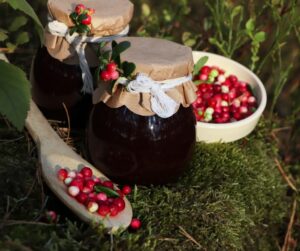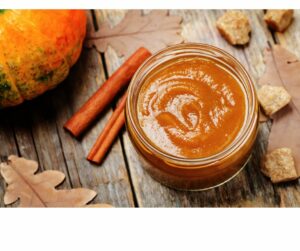
We’ve looked at heat, acid, and salt as food preservation ingredients. Now let’s have some sweet talk about sugar used in preserving.
Jams, jellies, marmalades, syrups, sauces, and chutneys all rely on sugar to create an inhospitable environment for bacteria to grow in. That sugar helps stop bacteria from growing. Unopened sweet preserves are shelf stable for months or years. Even once open, these preserves can last for months in the fridge.
Jam is made from whole, mashed, or cut fruits and has a high sugar content. Jellies have the fruit pieces removed leaving a clear, solid product. Marmalades and chutneys are really a type of jam. Syrup on the other hand is more like a jelly in that it is clear and without any solids in it. Spreads, by law here in Canada, have a higher percentage of fruit compared to jam.
All these types of preserves use pectin to help create a thick, spreadable product. Pectin is a soluble fibre (soluble meaning it will dissolve in liquid) that’s found in the pulp and peel of many types of fruits. Manufacturers of pectin extract it from the pulp and peel of citrus fruits such as lemons and oranges, and from apple peels.
Different fruits offer different levels of pectin. Apples, berries, and dates, for me, are the most versatile, most functional, and most nutritious, and they’re used widely in many cuisines. Fresh fruit and dried fruit have natural sugars as well as pectin and inherent moisture that allows them to impart their own sweetness and distinct flavour to preserves.
Pectin’s complex structure unravels when mixed with acid, sugar, and water. When pectin is heated, it is viscous. The result is a smooth gel texture when cooled. The firmness of the gel is dependent on the ratios of the pectin from the fruit, acidity, level of sugar, moisture, and hardness of the water. Calcium in hard water can have a positive effect on the strength of the gel.
Cooking your mix of fruit, acid, sugar and pectin allows these ingredients to blend and create a jam. The heat also helps the pectin thicken your jam mixture into a gel.
Using sterilized canning equipment and boiling the jam once it’s been sealed into the sterilized jars ensures that the jam is free of harmful bacteria and can be stored safely at room temperature for months or years.
Check out the In a pickle? blog post for answers to your most frequently asked questions about canning, including information about proper sterilization and heating.
Here are a few top tips from a seasoned jam maker – me!
To determine if you need to add more pectin to your cooked jam mixture
Gently shake 1 tsp (5 ml) of the juice from your cooked jam with 1 tablespoon rubbing alcohol. If the mixture forms a solid gel that can be picked up with a fork, then you have enough pectin in your jam. If the mixture doesn’t form a solid gel, add 1 ½ teaspoons of pectin for every cup of jam you have made.
To determine if you have enough acid in your jam mixture
Do a side-by-side taste test. Mix 1 teaspoon lemon juice, 3 tablespoons water and ½ teaspoon sugar in a glass. Taste it. Then taste the liquid from your batch of cooking or cooked jam. If the jam liquid is sweeter than the water mixture, the jam liquid needs a bit more acid. Add one tablespoon of lemon juice for every cup of jam that you have made.
To determine if your cooked jam has cooked and thickened enough
Using frozen berries makes this an easy autumn canning recipe.
Makes 5 – 250ml jars
1500g Fresh or frozen strawberries (about 6 cups)
62.5g lemon juice (1/4 cup)
600g Apples, peeled, cored, sliced (approximately 4 tart apples)
1.0kg Sugar (4 cups)
Hull and halve the strawberries.
If you’re using frozen strawberries, thaw the fruit and cut the berries in half. Keep the thawed juice and add it as part of the total strawberry weight). Measure out 1500 grams of strawberries and add them to a large, stainless steel pot. (Aluminum will leach from an aluminum pot when acid is present.)
Heat the strawberries to help release their natural pectin.
Add the apples to the pot. Bring everything to a boil and simmer for 10 minutes until the apples are soft.
Add the sugar and stir constantly until the sugar is dissolved.
Boil gently for another 10 minutes and then add the lemon juice and stir frequently until the mixture reduces in volume to about ½ its original quantity. Measure the temperature of the jam and make sure it’s at 220F (104C) or conduct one of the gel tests above.
Fill your sterilized jars with the hot jam mixture to ¼ inch for the top of a 250ml jars (or ½ inch from the top for 500ml jars).
Finish by boiling the sealed jars. The water should cover the top of the jars by 1 inch. Boil the jars for 15 minutes. The jam contents are ready when it reaches an internal temperature of 82C (180F)

Makes 5 -250ml jars
500 g 2 cups granulated sugar
250g 1 cup light brown sugar
1125g 4 ½ cups partridgeberries, fresh or frozen
625g 2 ½cups rhubarb, fresh or frozen, chopped into ¼“ chunks
187g 3/4 cup orange juice
3/4 tsp cinnamon
3/8 tsp nutmeg
3/16 tsp ginger
6 tsp finely grated orange rind
Add the partridgeberries, rhubarb, orange juice, spices and orange rind to a large pot. Heat to a boil and simmer for 5 minutes.
Add the brown sugar and white sugar to the mixture and stir constantly until the sugar is dissolved. Bring the pot back to a boil gently for 10 minutes.
Stir frequently until the mixture reduces in volume to about ½ its original quantity. Measure the temperature of the sauce and make sure it’s at 220F (104C) or conduct one of the gel tests above.
Fill your sterilized jars with the hot sauce mixture to ¼ inch for the top of a 250ml jars (or ½ inch from the top for 500ml jars).
Finish by boiling the sealed jars. The water should cover the top of the jars by 1 inch. Boil the jars for 15 minutes. The sauce is ready when it reaches an internal temperature of 82C (180F).

Makes 4- 250ml jars
1000g Pumpkin, washed, seeded, cooked, peeled (about 4 cups) can use canned pumpkin
500g light brown sugar (about 2 cups)
5g cinnamon (1 tsp)
2g nutmeg (1/2 tsp)
1g salt (1/4 tsp)
125g honey (1/2 cup)
125g orange juice (1/2 cup)
Place all the ingredients in a food processor and blend until you have a smooth, even mixture.
Transfer this mixture to a large pot. Bring to a boil then reduce the heat and gently boil the mixture for 20 minutes. At the end of 20 minutes, the mixture should have thickened and reached a temperature of 220F or 102C.
Fill your sterilized jars with the hot buttered pumpkin mixture to ¼ inch for the top of a 250ml jars (or ½ inch from the top for 500ml jars).
Finish by boiling the sealed jars. The water should cover the top of the jars by 1 inch. Boil the jars for 15 minutes. The jam contents are ready when they reach an internal temperature of 82C (180F).